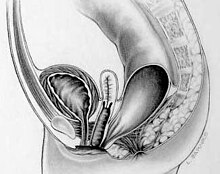Rectovaginal fistula
Rectovaginal fistulas , or (if they are below the dentate line are located) anovaginale fistulas are abnormal connections ( fistula ) between the rectum (rectal) or the anus and the vagina . The main symptom is the involuntary discharge of intestinal gas and stool via the vagina, and the resulting inflammation of the mucous membrane.
Epidemiology
Rectovaginal and other fistulas of the pelvic organs are common in developing countries, particularly Central Africa. These fistulas are usually caused by complicated, protracted births that result in pressure necrosis of the vaginal and intestinal walls . Due to poorly equipped obstetric care and the young (immature) age of many mothers, the disease is more common in developing countries. Other causes are rape and genital mutilation . In the industrialized countries, abdominal fistulas develop after radiation therapy of the pelvic organs and in Crohn's disease (a chronic, often fistulous intestinal inflammation).
diagnosis
The diagnosis can be made by the gynecologist through inspection and palpation . Imaging procedures such as proctoscopy ( rectoscopy ), fistula filling with X-ray contrast media , computed tomography and magnetic resonance imaging can show the extent and location of the fistula more precisely.
Socio-cultural consequences
Those affected, especially women from developing countries, suffer not only from the physical, but also from the socio-cultural consequences of the disease. The uncontrolled leakage of feces and intestinal gases creates an unpleasant odor, which often turns those affected into outcasts from society. Many fistula patients report social isolation, marginalization, shame and low self-esteem. A rectovaginal fistula also has a negative economic impact on the reality of life of the women concerned, as in most cases they can no longer go about their usual activities and therefore no longer provide financial support for the family.
treatment
Since the fistulas are usually trans- or extra- sphincter , treatment by simple surgical splitting of the tissue (opening lengthways ) is hardly an option. Instead, treatment consists of surgical excision and subsequent closure of the fistula with a flap . Severe inflammation and abscesses should be treated beforehand and, if possible, healed. Depending on the severity, a temporary artificial anus may have to be created. The surgery has reported success rates of 77 to 100%. There are endorectal and vaginal surgical techniques and access via the abdominal wall. Detailed evaluations of these variants are contained in the interdisciplinary S3 guideline of the AWMF , which, however, does not make a recommendation for a specific procedure due to insufficient data.
See also
Sources and individual references
- HBG Franz: Proctogynecology. In: The gynecologist. 2010, pp. 159-172, doi: 10.1007 / s00129-009-2507-7 .
- AWMF guidelines on rectovaginal fistula. Register number 088-004 (as of April 1, 2012)
- Committee 18: Fistulas in the Developing World. (PDF; 2.1 MB) In: Incontinence. 4th International Consultation on Incontinence. Paris 2008, Health Publication 2009, ISBN 978-0-9546956-8-2 .
- ↑ M. Muleta: Obstetric Fistula in Developing Countries: A Review Article. ( Memento of the original from December 20, 2015 in the Internet Archive ) Info: The archive link was inserted automatically and has not yet been checked. Please check the original and archive link according to the instructions and then remove this notice. (PDF; 576 kB) JOGC, 2006, pp. 962–966.
- ^ Women's Hope. In: www.womenshope.ch. Retrieved October 10, 2016 .
